11 Types of Natural Stone Countertops

When you hear natural stone countertops, you may think about gorgeous slabs with high prices and challenging installation. Although you are not completely wrong, simply skipping stone countertops when looking for your new countertop because of said reasons may not be the best choice.
A lot of traffic and interactions happen in the kitchen. And inside it, the countertop, being the work surface, is the part that receives most of the action. The key is to find a material capable of withstanding your day-to-day life: scratches, bumps, high temperatures, moisture, etc.
Furthermore, a good kitchen countertop should age according to its quality and maintain its original shape and color(s). Stone countertops are looking good already, right?
In a previous post, we covered various types of countertops with their pros and cons. In today’s post, we will take a look at natural stone countertops specifically.
Types of Stone Countertops
With natural stone countertops, you can enjoy a countertop with which you not only achieve functionality and beauty, but it will be an active part of your daily routine for a long time. After choosing a specific stone, you will have a wide range of colors and patterns to find the perfect one.
Let us see what the most popular types of natural stone countertops are:
Granite Countertops
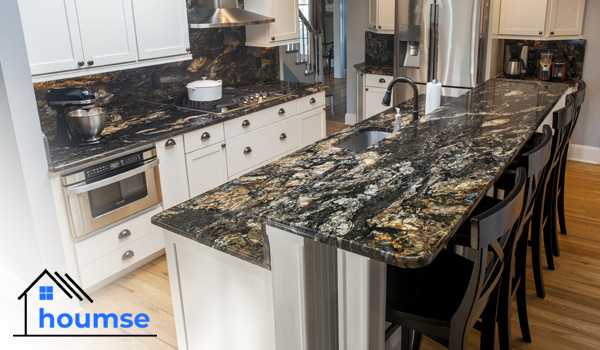
Due to its durability and resistance against heat and shock, granite is a very popular material for kitchen countertops. While offering simple maintenance and cleaning, granite countertops do not have a wide variety of finishes. However, as a natural stone, its appearance is elegant and unique in each slab.
Similar to other types, granite countertops are also polished, but you need to be careful with stains. This is because this material is porous, and a stain (if not dealt with quickly and properly) can leave a mark. To avoid this problem, protective treatment is applied. After purchasing and installing, you will need to regularly apply a suitable treatment as well.
Marble Countertops
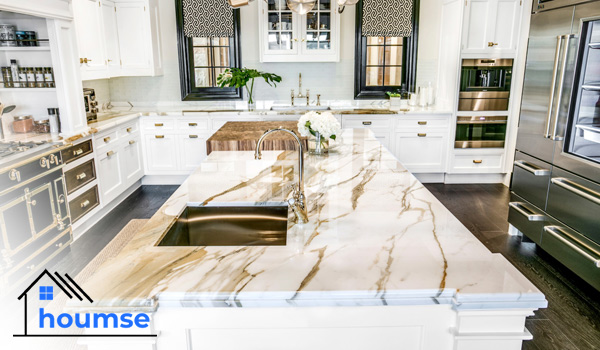
Marble may be the most favored material among natural stone countertops. Thanks to the warmth of its tones, it presents an extraordinary beauty, which is why it makes any environment elegant and sophisticated instantly like no other. It is a hard material; however, we should not forget that this stone is also porous.
This means that marble countertops absorb stains more easily, especially liquids that contain acids (such as lemon or vinegar, for example), fatty substances, and corrosive products, making them lose their beautiful shine. For this reason, it is highly recommended to clean such liquids quickly when poured on the surface.
Depending on the marble type, you will need to be careful with high temperatures, so make sure to use cutting boards and heat-resistant countertop protectors.
Quartz Countertops
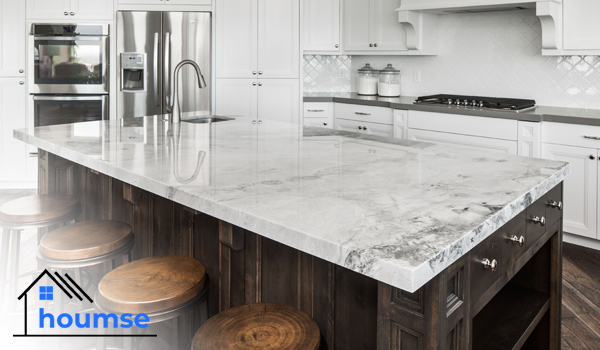
Quartz countertops offer a wide variety of shades and finishes. Composed of 90% to 95% quartz and other materials such as resins, they stand out for their resistance and low absorptiveness among types of natural stone countertops.
The unique pattern of a quartz slab extends over its entire surface, making it an interesting option as it adapts to any kitchen design. It is also hygienic and convenient to maintain. However, similar to marble, it does not handle high temperatures very well. They are not suitable for placing hot containers without protection, as it may leave a mark on them.
Laminam Stone Countertops
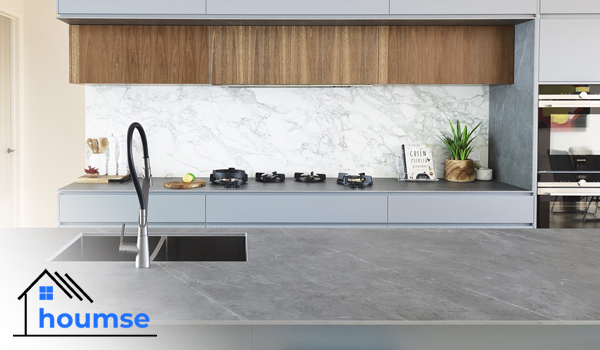
Laminam porcelain countertops may not be 100% one of the natural stone countertops, but you just cannot miss them when comparing different types of stone countertops. As an option with growing popularity, this material is one of the new-generation, high-tech engineered stones in the market.
The wide variety of textures and colors (from simple colors to marble-like appearance) make laminam a very interesting candidate. Additionally, unlike natural stone, this porcelain stone has an almost zero degree of absorption.
This important feature means that you do not need to worry about liquids. A feature that makes laminam countertops one of the most practical options. Hot containers are no problem either since these engineered stone countertops perfectly withstand heat in all circumstances.
Tip: You can purchase laminam porcelain countertops in large pieces that allow you to create extensive surfaces without joints. Perfect for using on the front (or backsplash), as a continuation of the countertop as well.
Quartzite Countertops
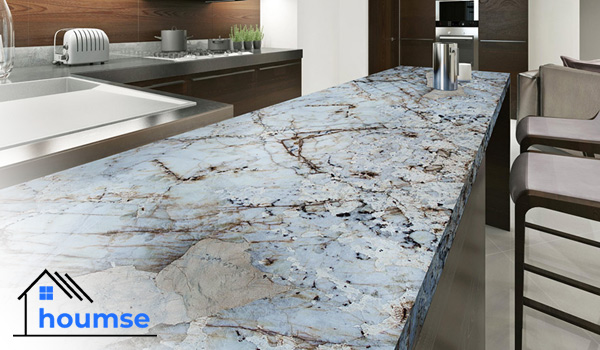
Quartzite is a relatively new option in natural stone countertops. But let us see what it is first. Natural stones with metamorphic origin are mainly formed by quartz, a sandstone rock of extraordinary hardness. When quartz is exposed to changing temperature and pressure, metamorphism occurs, and it becomes quartzite.
Because sandstone includes other types of minerals, the resulting quartzite can have a wide range of colors, white, gray, black, pink, reddish, etc. In hardness and resistance, you may compare quartzite to granite countertops, and for aesthetics to marble.
As kitchen countertops, this material is available in multiple finishes such as polished or matt. In any case, two of the most important factors when choosing a countertop -resistance to high temperatures and easy cleaning- are guaranteed with these types of stone countertops.
Onyx Countertops
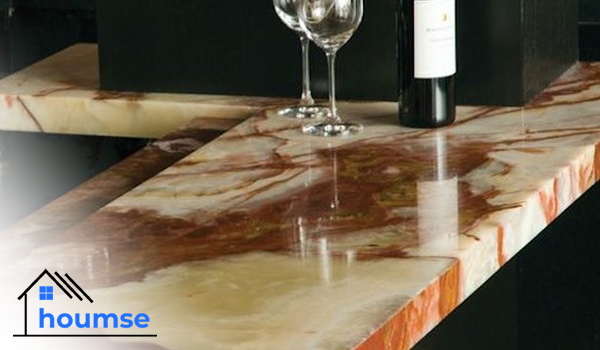
Onyx is a unique natural stone that comes from stalactite deposits in limestone caves. When the water in the stalactites and stalagmites in such caves evaporates, calcium carbonate remains. This forms streaks of colors, swirls, and patterns unique to onyx. It is like a translucent version of the marble.
Onyx is a sustainable natural stone, and like granite and marble, can last for many years if properly cared for. While durable, onyx is brittle. It is one of the less hardy natural stone countertops compared to granite which is considerably hard.
Onyx countertops need to be sealed every one to three years to maintain their durability and beauty. The frequency depends on the load on the surface, the cleaning products used, and the color of the stone (lighter surfaces fade more easily than darker ones and therefore need to be sealed more often).
Travertine Countertops
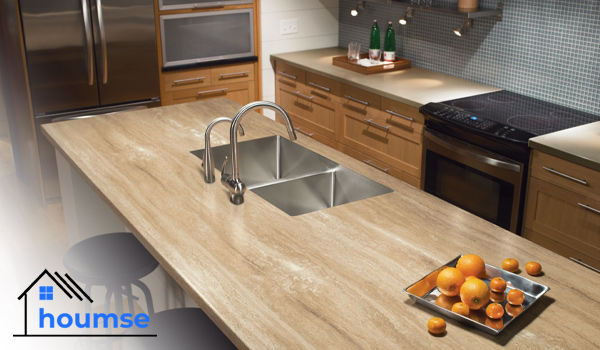
Similar to marble, travertine is also from the limestone family. The key difference is their formation. Both are subjected to high pressures and temperatures, but while marbles are metamorphic rocks, travertines are sedimentary rocks; formed in thermal caves and limestone caves.
When comparing types of natural stone countertops, the more uniform, shiny look of marble makes it unmistakable against the roughness and rusticity of travertine with its characteristic small holes. The color palette is not the same either.
Marble has numerous colors with signature veined patterns, from the light background tones (white, gray, beige, etc.) adorned with eye-catching pink, blue, green, and even black streaks. On the other hand, the travertine offers a spectrum of earth tones (cream, brown, gold, and even reddish), perfect for achieving a natural and warm touch.
Travertine countertops may not be as beautiful as bold stone countertops like marble, but they are economical alternatives that require less attention.
Soapstone Countertops
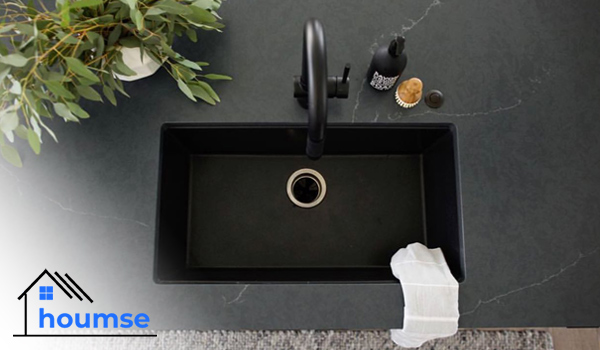
Soapstone is a metamorphic rock containing talc (about 50%). If you know minerals, you probably know that talc is very soft. Therefore, soapstone has a smoother consistency than other common types of stone countertops. In fact, it was named for its similarity to a bar of soap.
However, in different slabs, the percentage of talc can vary, so some are harder than others, and the slabs used for kitchen countertops fall in the harder range. Soapstone’s range of shades is on the darker end of the spectrum. So, if you are looking for a rustic feel, it can be the right aesthetic fit. But, if you prefer a modern farmhouse look, other stone countertops may be better. Depending on the way you use your kitchen countertop, this may not be ideal for you.
We mentioned that it is a soft material, so if you have children at home, or you prefer to cut things straight on the counter, rather than using a cutting board, etc. you may want to purchase a more durable option. Fortunately, when soapstone countertops get scratched, it can be sanded to correct, but the finish might not be perfect.
The color palette is somewhat limited as well, gray, and black tones are the most common. But all of these should not let you forget about its advantages such as its dramatic, aged look, waterproofness, high resistance to staining as well as high temperature (you can even put a hot pan on it without any damage).
Limestone Countertops
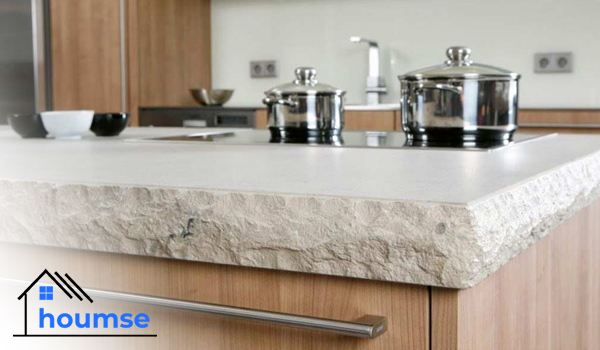
Limestone is a very resistant stone for a kitchen countertop with a reasonable price and easy maintenance. To ensure your faith in this material, keep in mind that some of the oldest known sculptures are made with this material.
With beige to tan-brown hues, these countertops create a warm space. However, since they are mostly made of calcium minerals, make sure to clean acidic solutions quickly with a suitable cleaner.
Corian Countertops
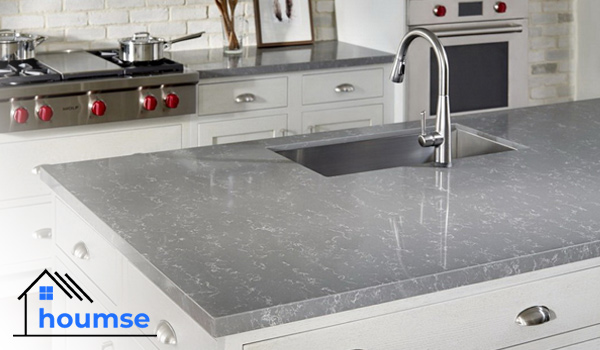
Corian® Design material is a registered trademark of the Dupont company, first introduced in 1967 and marketed as a “product of the space age”. Although it was the first solid surface on the market, today there are different manufacturers of the same product with slight differences in the “recipe”, but the result is essentially the same.
Regarding the composition, Corian countertops are synthetic and are made by mixing a third of acrylic resin, two-thirds of minerals derived from natural stones, and pigments for the final color. The appearance is the same both on the inside and on the outside, which is why it is considered solid (solid surface).
Compared to other types of stone countertops, Corian countertops have notable advantages. For example:
- It is non-porous; this means that liquids do not penetrate it and you can easily clean the countertop with usual cleaning products without leaving stains.
- Cracks, scratches, etc. can be repaired. Thanks to the fact that it is a solid surface, maintenance is very simple.
- You can install Corian countertops without showing the joints between the different pieces, thus achieving a visually uniform look, which is difficult to achieve in other stone countertops.
- It has a fairly wide color palette, so you will have no problem matching it with the style and design of the kitchen.
- It is moldable and therefore any size and shape can be achieved.
These countertops have disadvantages as well. First, they are pricy. Second, despite being very hard, it is more sensitive to scratches than other products (the good news is that you can repair it by sanding). Lastly, although the manufacturer assures that these solid surface countertops support 100ºC, but since high temperatures are one of their great weaknesses, always use protective pads.
Slate Rock Countertops
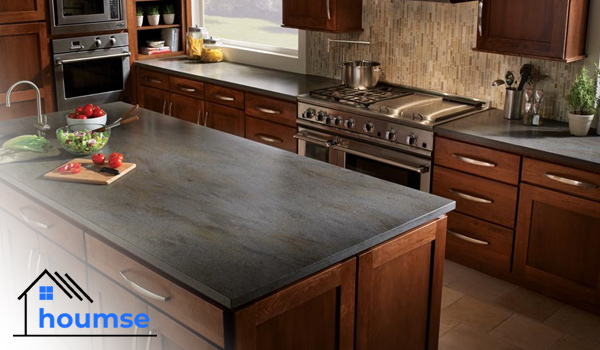
Slate rock is not a new name among other types of stone countertops. This metamorphic rock is made of highly pressurized shale and clay (for the most part).
It features a soft glossy finish that protects it from stains and moisture, making it practical and easy to use. Apart from practicality, it brings a historical feel to your space whether it is indoor or outdoor like no other.
- In this post:
- Types of Stone Countertops



